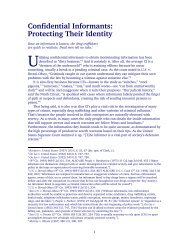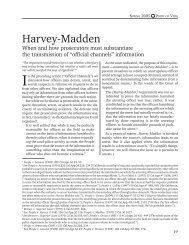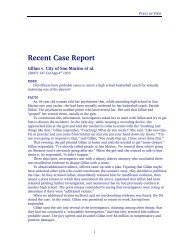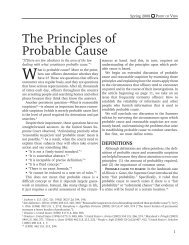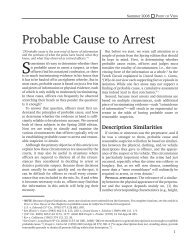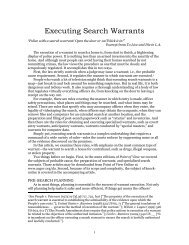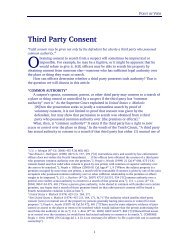Protecting Surveillance Sites - Alameda County District Attorney's ...
Protecting Surveillance Sites - Alameda County District Attorney's ...
Protecting Surveillance Sites - Alameda County District Attorney's ...
Create successful ePaper yourself
Turn your PDF publications into a flip-book with our unique Google optimized e-Paper software.
Clear view: Even if the observations were somewhat material, the view from<br />
the surveillance site was so clear and unobstructed that there is no reasonable<br />
possibility the defense would be able to effectively challenge the accuracy of<br />
the officer’s observations.<br />
Observations not significant<br />
A surveillance location is less apt to be deemed material if the prosecution can<br />
prove the officers’ observations from the location were not necessary to establish<br />
the defendant’s guilt. There are essentially two ways of doing this: (1)<br />
Demonstrating that the evidence of defendant’s guilt—independent of<br />
surveillance—is so strong that the location of the surveillance site is irrelevant.<br />
(2) Demonstrating that because of the specific charges filed against the<br />
defendant, knowledge of the surveillance location is irrelevant.<br />
STRENGTH OF EVIDENCE: The greater the quantity and quality of the evidence<br />
of the defendant’s guilt, apart from surveillance, the less disclosure of the location<br />
is needed to assure the defendant of a fair trial. Thus, the prosecution may<br />
attempt to prove the evidence obtained as the result of surveillance is relatively<br />
insignificant in light of the other evidence.<br />
For example, if the defendant was charged with possession of drugs for sale,<br />
the materiality of the surveillance observations would be reduced to the extent<br />
the defendant’s intent to sell drugs could be established by other means; e.g., the<br />
drugs were packaged for sale, or the quantity of drugs in his possession was so<br />
great that it would have been beyond belief that they were intended for personal<br />
use.<br />
Thus, in People v. Garza, 8 the court in refusing to order disclosure noted,<br />
among other things, “[A]t the time of his arrest defendant had on his person four<br />
bindles of cocaine. [Narcotics officers] testified that four bindles of cocaine in<br />
defendant’s possession were sufficient to show that the possession was for sale. . .<br />
. [The officer] further testified that even removing from the evidence his<br />
observations from the surveillance location, he would still consider the four<br />
bindles in defendant’s possession as being possessed for sale.”<br />
Similarly, the significance of the surveillance observations would be reduced if<br />
the defendant admitted selling drugs or admitted engaging in the conduct which<br />
was observed by officers, or if person who purchased drugs was detained and<br />
found to be in possession of drugs. 9<br />
NATURE OF CHARGES: The importance of the surveillance observations may<br />
also be reduced or eliminated by the nature of the charges that were eventually<br />
filed against the defendant. 10 For example, if the defendant is charged only with<br />
straight possession of drugs or other contraband that was found in his<br />
possession, his actions observed during surveillance before the contraband was<br />
found would be much less material than if he was charged with possession with<br />
intent to sell.<br />
Clear view<br />
In many cases, the defense contends it needs to know the exact location where<br />
surveillance occurred in order to attack the accuracy of the officers’ observations



